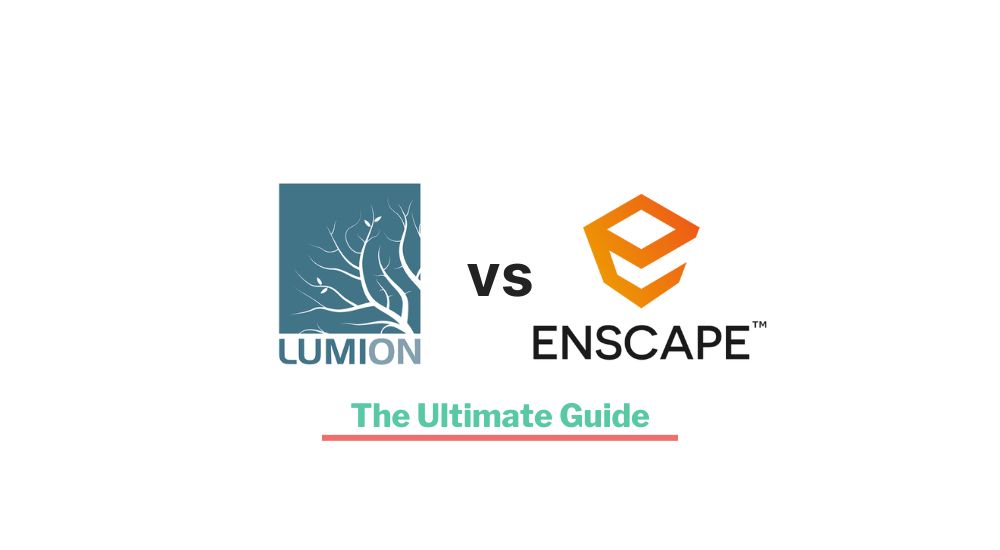Lumion vs Enscape: a battle for rendering championship. Both tools have captivated architects for years, and regardless of which camp you fall into, your rendering tool has probably become an indispensable part of your architecture toolkit.
Today we will look at the key differences between Enscape and Lumion to see which software works better for your rendering needs.
Differences Between Enscape and Lumion
Lumion first came to market in 2010 by Act-3D. At the time, it was the de-facto rendering software for architects, quickly capturing the market for the next five years, until Enscape came out in 2015.
While Lumion contains a strong library of effects and objects, Enscape has a quicker and easier rendering output. This means you can get more done with Enscape in a shorter period of time.
The downside? Quality.
Ease of Use
Enscape plugs directly into Revit, which means it has less options for controls. It’s easier, but there is less availability of control of designs with Enscape.
Lumion, as a standalone software, has more control over effects than Enscape. It’s also easy to use, but does have a learners curve of course.
System Requirements
Enscape requires a graphics card 4 GB of VRAM that supports Vulkan 1.1. They suggest any graphics card at the GeForce GTX 900 series or above.
Lumion, on the other hand, requires a graphics card with at least 4 GB of RAM, but strongly recommends at least 8 GB. You won’t get away with a 900 series graphics card either, Lumion’s minimum requirements fall near the GTX 1650, but they recommend an RTX 2070 or above for real design projects
Related: The Best Laptops For Running Lumion
Enscape will require less GPU power, making it a better option for those not running a state of the art computer or a dedicated computer for rendering.
Creating A Scene in Lumion vs Enscape
As Lumion is a standalone software, you will need to import your scenes to Lumion from your 3D modeling software. Lumion also comes with a wealth of scenes and objects to choose from, one of the main reasons that architects love Lumion.
As far as Enscape goes, it will render on top of Revit, meaning you don’t need to worry about importing your scenes. The limitation here is that Enscape will not provide the same depth of a library as Lumion has created, as it’s not a standalone software.
Enscape will help you review scenes quicker, which is better if you’re making changes on the fly, but Lumion will come out cleaner and look nicer, better for a final design.
For a final rendering image to provide to a client, Lumion takes the crown in terms of quality.
Setting Up Animation and Rendering
In regards to a walkthrough, Enscape will serve you better. It’s faster and easier to create the animated walkthroughs. Again, Enscape will be faster but have less depth to it’s animation
Both solutions allow you to send a link to a client to do a walkthrough without the client needing to download the software to view.
You can adjust on the fly rather quickly with Enscape, but Lumion will end up with a crisper finish. If you’re mid-project and still receiving feedback, Enscape will make your life easier. If you’re at the final stages of a project and ready for presentations, Lumion will be your champion.
Support
One of the most important elements for most users is the level of support they receive. And that’s not just customer service, that’s community support as well.
Lumion has 28 tutorials available, over 400 Knowledge Base questions answered, an active community forum, and customer care is available Mon-Fri from 9am-5pm EST.
Enscape also has an active community forum, 18 training videos, over 300 Knowledge Base questions, and sample projects available. Enscape does not have an easily accessible customer care line available.
Overall, Lumion has slightly better customer support, while both have robust community support.
Pricing & License Options
Lumion Pro, the full version without a limited library, comes in at a steep rate of nearly $1,500. They offer a discounted $1,299 for the first year on new signups, and have great student discounts as well. Overall, this is a premium, expensive option.
Enscape, on the other hand, offers more tiered pricing. If you are sure you will only use Enscape on one device, it can be as cheap as $515 for the year (they also have a monthly pricing option). If you want a “floating desk” option (meaning you can run Enscape on multiple computers) it will cost closer to $900 for the year.
Enscape is the clear winner in terms of pricing options here.

